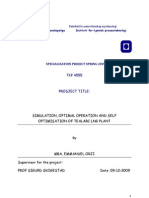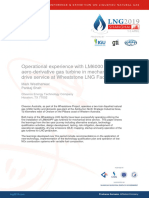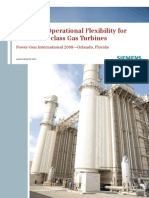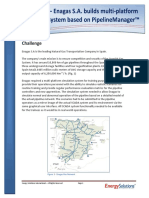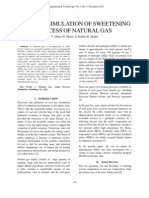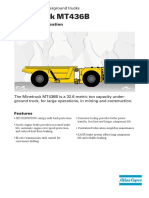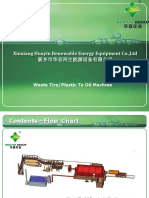APCI Process
Uploaded by
Mario MontessoriAPCI Process
Uploaded by
Mario MontessoriThe Second International Energy 2030 Conference
lali Performance Enhancement of APCI LNG Plant
A. Mortazavi1, Y. Hwang1, R. Radermacher1, S. Al-Hashimi2 and P. Rodgers3
1
Department of Mechanical Engineering, University of Maryland, College Park, U.S.A.
2
Department of Chemical Engineering, The Petroleum Institute, Abu Dhabi, U.A.E.
3
Department of Mechanical Engineering, The Petroleum Institute, Abu Dhabi, U.A.E.
Abstract
Chemical and gas plants are energy-intensive facilities so that any enhancement of their efficiency will
result in abundant reduction of energy consumption and green house gas emissions. Liquefied natural gas
(LNG) plants consume a great amount of energy. In order to enhance LNG plant energy efficiency, the
potential of various options for improving liquefaction cycle efficiency is investigated in this study. After
developing models for the LNG process using ASPEN software, four expansion loss recovery options are
simulated. The simulation results show that the compressor power reduction, expansion work recovery,
and LNG production increase can be achieved as much as 2.187 MW, 3.9 MW, and 1.24%, respectively,
by replacing conventional expansion processes with expanders. Therefore, the expansion work recovery is
an important option to be implemented in LNG plants.
1. Introduction
The petroleum and gas industries are significant energy consumers. About 15% of fossil fuels are
consumed in the production, process, and transport of fuels. Since natural gas is one of the cleanest fossil
fuels, the natural gas demand has increased recently. However, LNG plants are large energy consumers.
There are various ways to enhance LNG plant energy efficiency, such as improving liquefaction cycle
efficiency, improving compressor driver efficiency and utilizing waste heat. In order to investigate the
potential of various solutions for improving liquefaction cycle efficiency, several options to recover
expansion losses were modeled using ASPEN software, which is one of the preferred software in the oil
and gas industry.
2. Natural Gas Liquefaction Process
About 77% of LNG plants, including one at Abu Dhabi in the U.A.E., are using the propane pre-cooled
multi component refrigerant (MCR) cycle licensed by Air Products and Chemicals, Inc. (APCI) for natural
gas liquefaction, as illustrated in Figure 1 [1].
As shown in Figure 1, the feed gas is passed through the gas sweetening plant for the removal of H 2S,
CO2, H2O and Hg. As it passes through the pre-cooler and cold box, its temperature decreases to about -
30 C and some components condense at the same time. In the separator, the remaining gas and condensate
Figure 1. Schematic illustration of an LNG production process.
Abu Dhabi, U.A.E., November 4-5, 2008 99
The Second International Energy 2030 Conference
are separated. The condensate is being sent to the fractionation unit, where it is separated to propane,
butane, pentane, and heavier hydrocarbons. The gas is further cooled in the cryogenic column to below -
160 C and liquefied. Its pressure is then reduced to atmospheric pressure by passing through the LNG
expansion valve. There are two refrigeration cycles utilized in this whole process: the propane cycle and
the MCR cycle. The first cycle provides the required cooling to the pre-cooler, cold box and fractionation
plant. The second cycle supplies the cooling demand of the cryogenic column.
3. Model Development
ASPEN Plus, which is steady-state process modeling software, was employed for modeling the APCI
LNG production process [2]. ASPEN has a range of database containing thermodynamic and chemical
properties for a wide variety of chemical compounds and thermodynamic models for simulation of thermal
systems. An ASPEN model is based on blocks corresponding to unit operations such as compressors, heat
exchangers and expansion valves. By interconnecting the blocks using material (fluid), work and heat
streams a complete process flow sheet can be constructed. Simulation is performed by specifying the
following parameters:
Flow rates, compositions and operating conditions of the inlet streams.
Operating conditions of the blocks used in the process, e.g. temperature and pressure.
Operating heat and/or work inputs into the process.
Based on these input data, the model computes flow rates, compositions and state conditions of all
outlet material streams as well as the heat and work output. For modeling the property of substances, the
Peng-Robinson-Boston-Mathias equation of state was used [3]. Convergence tolerance for all ASPEN
models was set to 1x10-4 . For the sake of simplicity the gas sweetening process was not modeled. The gas
composition provided for the liquefaction cycle is listed in Table 1. Hexane plus was approximated by n-
hexane and iso-hexane with 0.16 and 0.24 for their mole fractions, respectively. Some of the other
modeling assumptions used are summarized in Table 2. Propane and MCR compressors were assumed to
be centrifugal and axial types, respectively. It was assumed that condensers and inter-coolers were cooled
by sea water. The propane cycle was assumed to have five stages of cooling. The MCR consisted of
nitrogen, methane, ethane, and propane with mole fractions of 0.09, 0.36, 0.47 and 0.08, respectively. The
MCR compressor had an intercooler, which was cooled by sea water. The fractionation unit was modeled
by using radfrac component of ASPEN [3]. All the expansion processes of the APCI cycle were done
by expansion valves, which is true for some of APCIs LNG plants. This cycle option is referred as APCI
base cycle in this paper. Flash gas recovery process is not considered. The schematic of the APCI base
cycle modeled in ASPEN is shown in Figure 2.
Table 1. Gas composition after sweetening.
Component Mole Fraction [%]
Nitrogen 0.1
Carbon Dioxide 0.005
Methane 85.995
Ethane 7.5
Propane 3.5
i-Butane 1
n- Butane 1
i-Pentane 0.3
n-Pentane 0.2
Hexane Plus 0.4
Total 100
Table 2. Model assumptions.
Axial compressor isentropic efficiency 0.86
Centrifugal compressor isentropic efficiency 0.83
Pinch temperature 3K
Sea water temperature 35°C
Refrigerant temperature at condenser or super heater exit 40°C
LNG temperature at the exit of cryogenic column -160°C
Degree of superheating in propane cycle 10 K
LNG expander exit pressure 101.3 kPa
Abu Dhabi, U.A.E., November 4-5, 2008 100
The Second International Energy 2030 Conference
Figure 2. APCI base cycle modeled with ASPEN.
4. Results of APCI Base Cycle Model
The entire APCI base cycle except the gas sweetening process was modeled with ASPEN. The results
of the APCI base cycle model are shown in Table 2. These results could be enhanced by recovering
expansion losses in refrigerant cycles and LNG expansion process, which is discussed in the next section.
Table 2. Model results for APCI base cycle.
Propane compressor power 35.317 MW
Mixed refrigerant compressor power 66.534 MW
Propane cycle cooling capacity 115.469 MW
Mixed refrigerant cycle cooling capacity 67.635 MW
Propane cycle COP 3.267
LNG vapor fraction after the expander 0.014 %
LNG production 98.83 kg/s
LPG (propane, butane, pentane and heavier hydrocarbons) 11 kg/s
Flash gas flow rate after LNG expander valve 1.28 kg/s
5. Base Cycle Enhancements
The APCI base cycle efficiency could be improved by replacing expansion valves with expanders.
Liquid turbines or hydraulic turbines are a well established technology. They are available with
efficiencies over 90% [4]. They can easily replace expansion valves used in the MCR cycle and the LNG
expansion process. In order to apply them to the propane cycle, propane should be sub-cooled before
entering the turbine, however. Two-phase expanders are under development with current efficiencies in
the vicinity of 80% [5,6]. They can easily replace expansion valves used in vapor compression cycles. For
expanding gases, gas expanders could be used instead of expansion valves. Gas expanders or gas turbines
are a readily available technology and typically exist with efficiencies greater than 80% [7].
The effect of replacing expansion valves used in the MCR and propane cycles and the LNG expansion
process with expanders was investigated. Depending on their locations, liquid turbines and two-phase
expanders could replace expansion valves. For the expansion valves used in the MCR cycle and the LNG
expansion process, only two-phase expanders were considered. For the expansion valves used in the
propane cycle, both two-phase expanders and liquid turbines were considered. Except for the case of using
two-phase expander for the LNG expansion process, a gas expander was considered to replace the
expansion valve of the first stage of the propane cycle, which had the highest evaporating pressure. The
isotropic efficiency of the gas expander, liquid turbines and two-phase expanders were assumed to be 0.86,
0.85 and 0.85, respectively. The results of these enhancements are shown in Table 3.
Abu Dhabi, U.A.E., November 4-5, 2008 101
The Second International Energy 2030 Conference
As can be seen from Table 3, the APCI cycle enhanced with two-phase expanders and liquid turbines
for LNG and propane expansion process, shown in Figure 3, is the most efficient cycle among the cycles
investigated.
Its total power consumption, flash gases after the LNG expander and energy consumed per unit mass of
LNG are lower than those of the APCI base cycle approximately by 2.15, 96.09 and 3.39 percent,
respectively. It is also able to recover about 3.83 percent of total consumed power. The LNG production
is also higher than that of the APCI base cycle by 1.24% from the same amount of feed gas. The
coefficient of performance (COP) of mixed refrigerant cycle is not considered due to the fact that it
receives cooling from the propane cycle. Therefore, the conventional definition of COP, which is the ratio
of the cooling capacity provided and the amount of power provided to the system is not suitable.
Table 3. Model results for APCI enhanced cycles.
Enhanced
Enhanced
Enhanced with two-
Enhanced with two-
with two- phase
with two- phase
phase expanders
Base phase expanders
expanders and liquid
Cycle Option APCI expanders for LNG,
for LNG and turbines for
cycle for LNG MCR, and
MCR LNG and
expansion propane
expansion propane
process expansion
process expansion
process
process
Propane cycle compressor power [MW] 35.317 35.317 34.766 34.637 34.296
MCR cycle compressor power [MW] 66.534 66.534 65.375 65.375 65.368
Propane cycle cooling capacity [MW] 115.469 115.469 113.939 113.937 113.962
MCR cycle cooling capacity [MW] 67.635 67.635 67.634 67.635 67.631
Propane cycle COP 3.267 3.267 3.277 3.289 3.323
LNG vapor fraction after the expander 0.0142 0.0006 0.0006 0.0006 0.0006
LNG production [kg/s] 98.83 100.06 100.06 100.06 100.06
LPG (propane, butane, pentane and
11 11 11 11 11
heavier hydrocarbons) production [kg/s]
Flash gases after LNG expander [kg/s] 1.28 0.05 0.05 0.05 0.05
Recovered power from expanders [MW] --- 0.648 2.528 3.296 3.821
Total power consumption [MW] 101.851 101.851 100.141 100.012 99.664
Energy consumption per unit mass of
1.031 1.018 1.001 1.000 0.996
LNG [MJ/kg]
Note: LPG = liquefied petroleum gas. MCR = multi-component refrigerant.
Figure 3. APCI Cycle Enhanced with two-phase expanders and liquid turbines for LNG and propane
expansion processes.
Abu Dhabi, U.A.E., November 4-5, 2008 102
The Second International Energy 2030 Conference
6. Conclusions
Liquefied natural gas (LNG) plants consume great amount of energy. In order to enhance LNG plants
energy efficiency, potentials of various options for improving liquefaction cycle efficiency were
investigated in this study. After developing models for the LNG process using ASPEN software, four
expansion loss recovering options were simulated. The simulation results show that the compressor power
reduction, expansion work recovery, and LNG production increase can be achieved as much as 2.187 MW,
3.9 MW, and 1.24%, respectively, by replacing conventional expansion processes with expanders.
Therefore, the expansion work recovery is an important option to be implemented in the LNG plants.
7. References
1. Barclay, M., Selecting offshore LNG processes, LNG Journal, October 2005, pp. 34-36.
2. Aspen Plus, Version 2006, Aspen Technology Inc., 200 Wheeler Road Burlington, MA, U.S.A.
3. Spilsbury, C., Liu, Y, Petrowski, J. and Kennington, W., Evolution of Liquefaction Technology for
todays LNG business, 7° Journess Scientifiques et Techniques, November 2006, Oran, Algeria.
4. Gordon, J. L., Hydraulic turbine efficiency, Canadian Journal of Civil Engineering, 2001, V. 28, Issue
2, pp. 238-253.
5. Kanoglu, M., Cryogenic turbine efficiencies, Exergy International Journal, 2001, V. 1, No. 3, pp. 202
208.
6. Renaudin, G., Improvement of natural gas liquefaction processes by using liquid turbines, Proceedings
of the Eleventh International Conference on Liquefied Natural Gas, Institute of Gas Technology,
Chicago, 1995.
7. Ordonez, C. A., Liquid nitrogen fueled, closed Brayton cycle cryogenic heat engine, Energy
Conversion & Management, 2000, V. 41, pp.331-341.
8. Aspen Plus, Version 11.1 Documentation, Physical Property Methods and Models, reference manual,
2001, Chapter 2.
Author Biographies
Mr. Amir Mortavazi is currently pursuing his Ph.D. in Mechanical Engineering at the University of
Maryland. His current research is in modeling APCI LNG plants for waste heat utilization. He graduated
from The Sharif University of Technology with a B.S. in Mechanical Engineering.
Dr. Yunho Hwang, Ph.D., is a Research Associate Professor in the Department of Mechanical
Engineering at the University of Maryland. His research focuses on developing comprehensive information
for the detailed physics of transport processes, new cost-effective test methods, and innovative components
and system. He is responsible for Alternative Cooling Technologies and Applications Consortium
(ACTA) that is sponsored by the industry, government and research institutions.
Dr. Reinhard Radermacher, Ph.D., is a Professor in the Department of Mechanical Engineering at
the University of Maryland. He holds an M.S. and Ph.D. in Physics from the Munich Institute of
Technology. Dr. Radermacher is an internationally recognized expert in heat transfer and working fluids
for energy conversion systems, including heat pumps, air-conditioners, and absorption chillers.
Dr. Saleh Al Hashimi, Ph.D., an Assistant Professor in the Department of Chemical Engineering at
The Petroleum Institute, United Arab Emirates. He has expertise in mathematical modeling, catalysis and
waste heat management. He has been interested in applying novel systems to the petroleum industry to
make better use of the waste heat generated. Some of his recent publications in this area focus on crude oil
stabilization and polycarbonate plants.
Dr. Peter Rodgers, Ph.D., is Associate Professor of Mechanical Engineering at The Petroleum
Institute, U.A.E. He has extensive experience in thermofluid modeling and experimental characterization.
His current research activities are focused on waste heat utilization in the oil and gas industry; the
development of polymeric heat exchangers for sea water cooling applications; computational fluid
dynamics; electronics reliability; and engineering education. He is presently a member of several
international conference program committees, and serves as program co-chair for both EuroSimE 2009 and
Energy 2030. He has authored or co-authored over 60 journal and conference publications.
Abu Dhabi, U.A.E., November 4-5, 2008 103
You might also like
- Brayton Refrigeration Cycles For Small-Scale LNGNo ratings yetBrayton Refrigeration Cycles For Small-Scale LNG9 pages
- Technical Specification On Development of Construction Design For The Installation of Gas Compression Unit atNo ratings yetTechnical Specification On Development of Construction Design For The Installation of Gas Compression Unit at12 pages
- X-Stream BE Pressure Washer Hi-Pop ItemsNo ratings yetX-Stream BE Pressure Washer Hi-Pop Items40 pages
- A Comparative Study of Phillips Optimized Cascade and Apci Propane Pre-Cooled Mixed Refrigerant LNG Liquefaction ProcessesNo ratings yetA Comparative Study of Phillips Optimized Cascade and Apci Propane Pre-Cooled Mixed Refrigerant LNG Liquefaction Processes8 pages
- Simulation, Optimal Operation and Self Optimisation of Tealarc LNG Plant (2009)No ratings yetSimulation, Optimal Operation and Self Optimisation of Tealarc LNG Plant (2009)48 pages
- Pilot-Operated Safety Relief Valves A Simple, Effective Plant Upgrade - HP - Nov 2011 PDFNo ratings yetPilot-Operated Safety Relief Valves A Simple, Effective Plant Upgrade - HP - Nov 2011 PDF5 pages
- 170630-1201 MultiPoint-Flare-SS FINAL JZHCNo ratings yet170630-1201 MultiPoint-Flare-SS FINAL JZHC4 pages
- OTS Overview: Benefits, Requirements, Challenges and StrategiesNo ratings yetOTS Overview: Benefits, Requirements, Challenges and Strategies10 pages
- Benefits of Integrating NGL Extraction and LNG RecoveryNo ratings yetBenefits of Integrating NGL Extraction and LNG Recovery8 pages
- 20190130-TEC-WST-LNG19 LM6000 Techinical PaperNo ratings yet20190130-TEC-WST-LNG19 LM6000 Techinical Paper12 pages
- 2011 Relief-Devices Shattering ConsiderationsNo ratings yet2011 Relief-Devices Shattering Considerations13 pages
- PDF Refrigeration Compressor Driver SelectionNo ratings yetPDF Refrigeration Compressor Driver Selection27 pages
- Low Load Operational Flexibility For Siemens G-Class Gas TurbinesNo ratings yetLow Load Operational Flexibility For Siemens G-Class Gas Turbines17 pages
- Olefins From Conventional and Heavy Feedstocks100% (1)Olefins From Conventional and Heavy Feedstocks27 pages
- Woodward - SonicFlo Gas Valves, Hydraulically Actuated100% (1)Woodward - SonicFlo Gas Valves, Hydraulically Actuated4 pages
- Low Temperature Methane Gas Water Content - Campbell Tip of The MonthNo ratings yetLow Temperature Methane Gas Water Content - Campbell Tip of The Month4 pages
- Traditional Advanced Control StrategiesNo ratings yetTraditional Advanced Control Strategies48 pages
- Achieving Product Specifications For Ethane Through To Pentane Plus From NGL Fractionation PlantsNo ratings yetAchieving Product Specifications For Ethane Through To Pentane Plus From NGL Fractionation Plants21 pages
- Dynamic Decoupling in Gas Compressors 1696094753No ratings yetDynamic Decoupling in Gas Compressors 16960947534 pages
- Safety Moment 15 Common Process Safety Hazards Part 3No ratings yetSafety Moment 15 Common Process Safety Hazards Part 34 pages
- Hint An Educational Software For Heat Exchanger Network100% (1)Hint An Educational Software For Heat Exchanger Network9 pages
- ESI-Case-Study-Enagas-PLM-Pipeline TrainerNo ratings yetESI-Case-Study-Enagas-PLM-Pipeline Trainer5 pages
- CET 1112 012 Dynamic Simulation Sweetening Process Natural GasNo ratings yetCET 1112 012 Dynamic Simulation Sweetening Process Natural Gas6 pages
- Using Layers of Protection Analysis To Evaluate Fire and Gas SystemsNo ratings yetUsing Layers of Protection Analysis To Evaluate Fire and Gas Systems6 pages
- A Re-Think of The Mercury Removal Problem For LNG PlantsNo ratings yetA Re-Think of The Mercury Removal Problem For LNG Plants10 pages
- Liquid Cylinder Manual Cryo-DuraCyl (Contoh Tabung)No ratings yetLiquid Cylinder Manual Cryo-DuraCyl (Contoh Tabung)70 pages
- Operator Training and Simulation Fundamentals Distillation Operation100% (1)Operator Training and Simulation Fundamentals Distillation Operation2 pages
- Diversifying Level Measurement Technology in The LNG IndustryNo ratings yetDiversifying Level Measurement Technology in The LNG Industry3 pages
- Don' T Look at Precondensers in A VacuumNo ratings yetDon' T Look at Precondensers in A Vacuum3 pages
- Process System Value and Exergoeconomic Performance of Captive Power PlantsFrom EverandProcess System Value and Exergoeconomic Performance of Captive Power PlantsNo ratings yet
- API STD 617 Interview Questions and Answers: The Guide for Compressor and Pump EngineersFrom EverandAPI STD 617 Interview Questions and Answers: The Guide for Compressor and Pump EngineersNo ratings yet
- ISA Certified Control Systems Technician (CCST): Certification Exam Prep: 500 Practice Exam Questions and ExplanationsFrom EverandISA Certified Control Systems Technician (CCST): Certification Exam Prep: 500 Practice Exam Questions and ExplanationsNo ratings yet
- Production Availability and Reliability: Use in the Oil and Gas industryFrom EverandProduction Availability and Reliability: Use in the Oil and Gas industryNo ratings yet
- Compressors & Compressor Units World Summary: Market Sector Values & Financials by CountryFrom EverandCompressors & Compressor Units World Summary: Market Sector Values & Financials by CountryNo ratings yet
- Performance Enhancement of Propane Pre-C PDFNo ratings yetPerformance Enhancement of Propane Pre-C PDF7 pages
- 2x350MW Ghana Supercritical Coal Fired Power Plant - Scoping ReportNo ratings yet2x350MW Ghana Supercritical Coal Fired Power Plant - Scoping Report120 pages
- Scoping Report For Wind Power Project 1No ratings yetScoping Report For Wind Power Project 1205 pages
- Operating Principle of Diesel and Petrol EnginesNo ratings yetOperating Principle of Diesel and Petrol Engines8 pages
- PTC B1.1 Notes - Sub Module 17.7 (Propeller Storage and Preservation)100% (1)PTC B1.1 Notes - Sub Module 17.7 (Propeller Storage and Preservation)8 pages
- Technical Specification BIBO 2201.320: Product Material RatingNo ratings yetTechnical Specification BIBO 2201.320: Product Material Rating1 page
- D4 Productinfo IHC Beaver 50 Cutter Suction Dredger67% (3)D4 Productinfo IHC Beaver 50 Cutter Suction Dredger2 pages
- IPS E-ME-130 LPG Pressure Storage Spheres 22p Rev. 2011No ratings yetIPS E-ME-130 LPG Pressure Storage Spheres 22p Rev. 201124 pages
- Wellhead Control Panel (WHCP) : Product DescriptionNo ratings yetWellhead Control Panel (WHCP) : Product Description4 pages
- Minetruck MT436B 9851 2249 01N tcm833-1540890 PDFNo ratings yetMinetruck MT436B 9851 2249 01N tcm833-1540890 PDF4 pages
- A104 Fișă de Catalog Instalație de PirolizăNo ratings yetA104 Fișă de Catalog Instalație de Piroliză28 pages
- LP Gas Cylinder Storage Requirements - Quick Tips #139 - Grainger Industrial SupplyNo ratings yetLP Gas Cylinder Storage Requirements - Quick Tips #139 - Grainger Industrial Supply3 pages
- BRCM College of Engineering & Technology, BahalNo ratings yetBRCM College of Engineering & Technology, Bahal22 pages
- Aaaa-A (Aaa) - NNNNNN (A) : Piping ClassNo ratings yetAaaa-A (Aaa) - NNNNNN (A) : Piping Class1 page
- 1st Elgin Scouts Group Porta Cabin Risk Assessment 2019No ratings yet1st Elgin Scouts Group Porta Cabin Risk Assessment 20195 pages
- Class 10 Science Chapter 4 Carbon and Its Compounds Revision NotesNo ratings yetClass 10 Science Chapter 4 Carbon and Its Compounds Revision Notes30 pages
- Synthetic Fuels GTL f1 Fischer Tropsch Process2588570496085257524100% (1)Synthetic Fuels GTL f1 Fischer Tropsch Process25885704960852575248 pages
- Technical Specification On Development of Construction Design For The Installation of Gas Compression Unit atTechnical Specification On Development of Construction Design For The Installation of Gas Compression Unit at
- A Comparative Study of Phillips Optimized Cascade and Apci Propane Pre-Cooled Mixed Refrigerant LNG Liquefaction ProcessesA Comparative Study of Phillips Optimized Cascade and Apci Propane Pre-Cooled Mixed Refrigerant LNG Liquefaction Processes
- Simulation, Optimal Operation and Self Optimisation of Tealarc LNG Plant (2009)Simulation, Optimal Operation and Self Optimisation of Tealarc LNG Plant (2009)
- Pilot-Operated Safety Relief Valves A Simple, Effective Plant Upgrade - HP - Nov 2011 PDFPilot-Operated Safety Relief Valves A Simple, Effective Plant Upgrade - HP - Nov 2011 PDF
- OTS Overview: Benefits, Requirements, Challenges and StrategiesOTS Overview: Benefits, Requirements, Challenges and Strategies
- Benefits of Integrating NGL Extraction and LNG RecoveryBenefits of Integrating NGL Extraction and LNG Recovery
- Low Load Operational Flexibility For Siemens G-Class Gas TurbinesLow Load Operational Flexibility For Siemens G-Class Gas Turbines
- Woodward - SonicFlo Gas Valves, Hydraulically ActuatedWoodward - SonicFlo Gas Valves, Hydraulically Actuated
- Low Temperature Methane Gas Water Content - Campbell Tip of The MonthLow Temperature Methane Gas Water Content - Campbell Tip of The Month
- Achieving Product Specifications For Ethane Through To Pentane Plus From NGL Fractionation PlantsAchieving Product Specifications For Ethane Through To Pentane Plus From NGL Fractionation Plants
- Safety Moment 15 Common Process Safety Hazards Part 3Safety Moment 15 Common Process Safety Hazards Part 3
- Hint An Educational Software For Heat Exchanger NetworkHint An Educational Software For Heat Exchanger Network
- CET 1112 012 Dynamic Simulation Sweetening Process Natural GasCET 1112 012 Dynamic Simulation Sweetening Process Natural Gas
- Using Layers of Protection Analysis To Evaluate Fire and Gas SystemsUsing Layers of Protection Analysis To Evaluate Fire and Gas Systems
- A Re-Think of The Mercury Removal Problem For LNG PlantsA Re-Think of The Mercury Removal Problem For LNG Plants
- Liquid Cylinder Manual Cryo-DuraCyl (Contoh Tabung)Liquid Cylinder Manual Cryo-DuraCyl (Contoh Tabung)
- Operator Training and Simulation Fundamentals Distillation OperationOperator Training and Simulation Fundamentals Distillation Operation
- Diversifying Level Measurement Technology in The LNG IndustryDiversifying Level Measurement Technology in The LNG Industry
- Problem Solving for Process Operators and SpecialistsFrom EverandProblem Solving for Process Operators and Specialists
- Process System Value and Exergoeconomic Performance of Captive Power PlantsFrom EverandProcess System Value and Exergoeconomic Performance of Captive Power Plants
- API STD 617 Interview Questions and Answers: The Guide for Compressor and Pump EngineersFrom EverandAPI STD 617 Interview Questions and Answers: The Guide for Compressor and Pump Engineers
- ISA Certified Control Systems Technician (CCST): Certification Exam Prep: 500 Practice Exam Questions and ExplanationsFrom EverandISA Certified Control Systems Technician (CCST): Certification Exam Prep: 500 Practice Exam Questions and Explanations
- Production Availability and Reliability: Use in the Oil and Gas industryFrom EverandProduction Availability and Reliability: Use in the Oil and Gas industry
- Compressors & Compressor Units World Summary: Market Sector Values & Financials by CountryFrom EverandCompressors & Compressor Units World Summary: Market Sector Values & Financials by Country
- 2x350MW Ghana Supercritical Coal Fired Power Plant - Scoping Report2x350MW Ghana Supercritical Coal Fired Power Plant - Scoping Report
- PTC B1.1 Notes - Sub Module 17.7 (Propeller Storage and Preservation)PTC B1.1 Notes - Sub Module 17.7 (Propeller Storage and Preservation)
- Technical Specification BIBO 2201.320: Product Material RatingTechnical Specification BIBO 2201.320: Product Material Rating
- D4 Productinfo IHC Beaver 50 Cutter Suction DredgerD4 Productinfo IHC Beaver 50 Cutter Suction Dredger
- IPS E-ME-130 LPG Pressure Storage Spheres 22p Rev. 2011IPS E-ME-130 LPG Pressure Storage Spheres 22p Rev. 2011
- Wellhead Control Panel (WHCP) : Product DescriptionWellhead Control Panel (WHCP) : Product Description
- LP Gas Cylinder Storage Requirements - Quick Tips #139 - Grainger Industrial SupplyLP Gas Cylinder Storage Requirements - Quick Tips #139 - Grainger Industrial Supply
- 1st Elgin Scouts Group Porta Cabin Risk Assessment 20191st Elgin Scouts Group Porta Cabin Risk Assessment 2019
- Class 10 Science Chapter 4 Carbon and Its Compounds Revision NotesClass 10 Science Chapter 4 Carbon and Its Compounds Revision Notes
- Synthetic Fuels GTL f1 Fischer Tropsch Process2588570496085257524Synthetic Fuels GTL f1 Fischer Tropsch Process2588570496085257524







